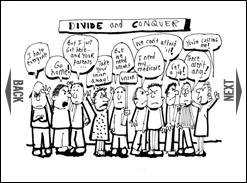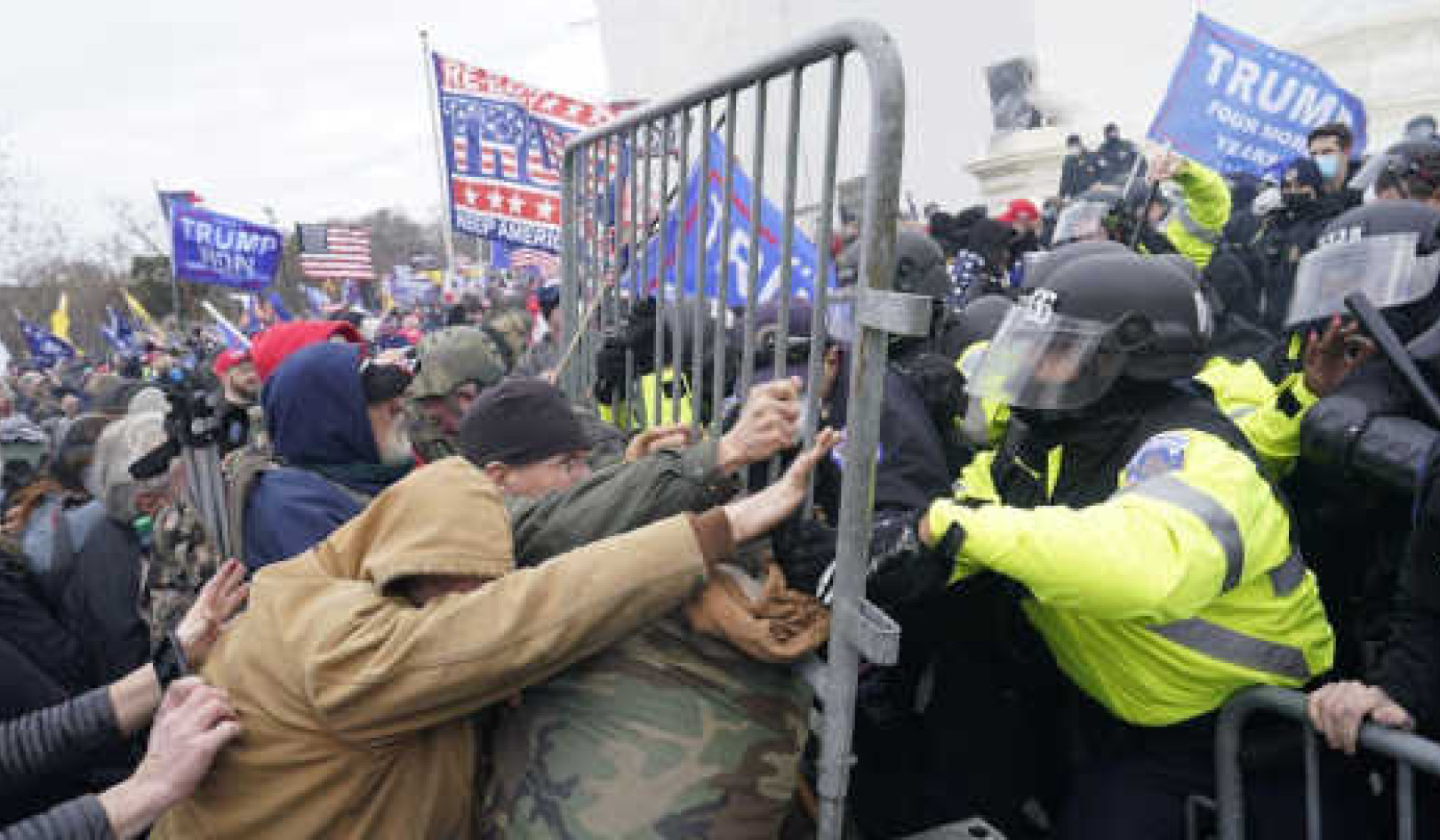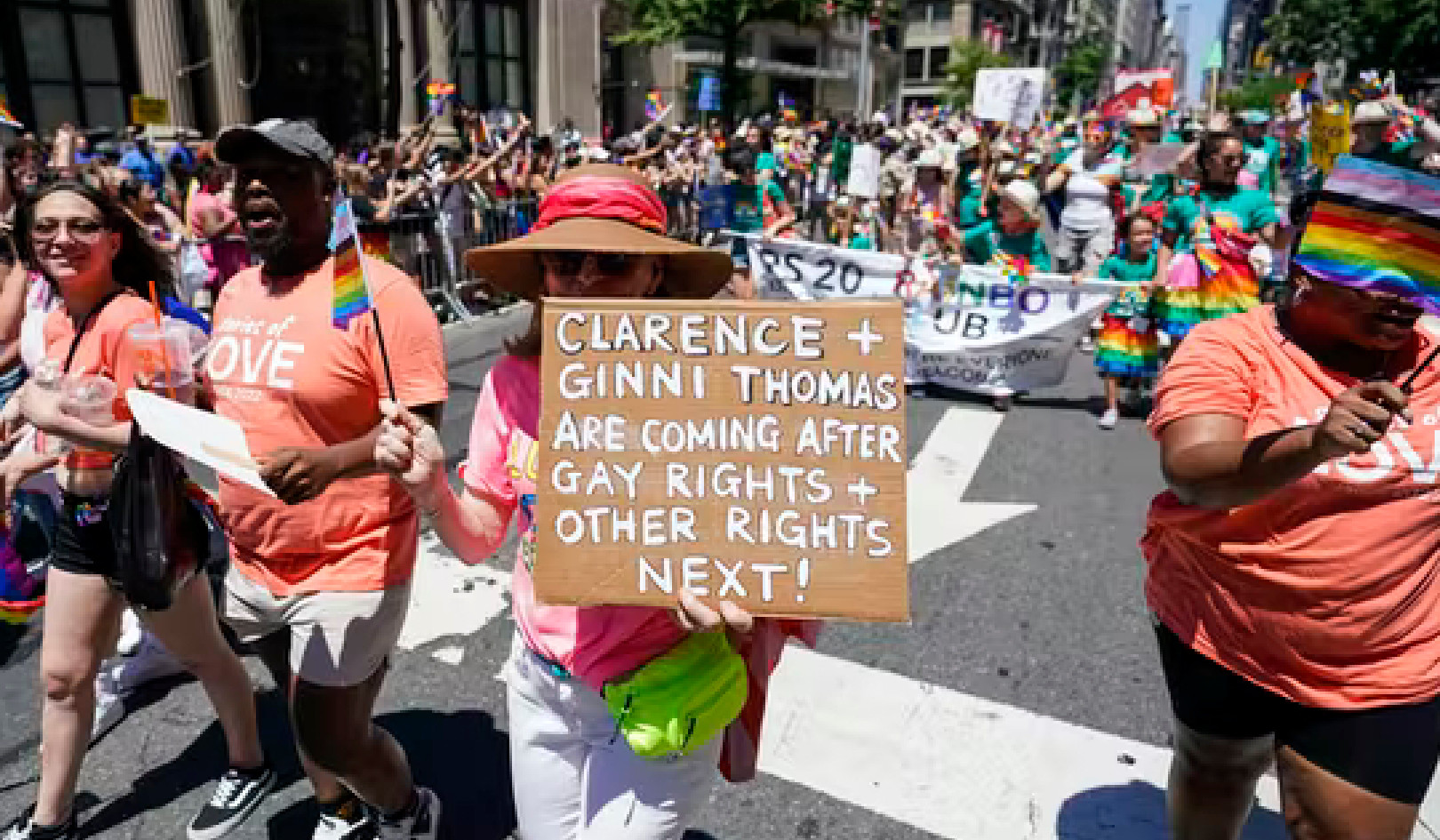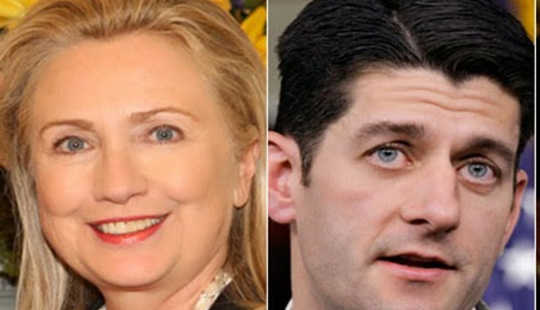 Third parties have rarely posed much of a threat to the dominant two parties in America. So how did the People’s Party win the U.S. presidency and a majority of both houses of Congress in 2020?
Third parties have rarely posed much of a threat to the dominant two parties in America. So how did the People’s Party win the U.S. presidency and a majority of both houses of Congress in 2020?
It started four years before, with the election of 2016.
As you remember, Donald Trump didn’t have enough delegates to become the Republican candidate, so the GOP convention that summer was “brokered” – which meant the Party establishment took control, and nominated the Speaker of the House, Paul Ryan.
Trump tried to incite riots but his “I deserve to be president because I’m the best person in the world!” speech incited universal scorn instead, and he slunk off the national stage (his last words, shouted as he got into his stretch limousine, were “Fu*ck you, America!”)
On the Democratic side, despite a large surge of votes for Bernie Sanders in the final months of the primaries, Hillary Clinton’s stable of wealthy donors and superdelegates put her over the top.
Both Republican and Democratic political establishments breathed palpable sighs of relief, and congratulated themselves on remaining in control of the nation’s politics.
They attributed Trump’s rise to his fanning of bigotry and xenophobia, and Sanders’s popularity to his fueling of left-wing extremism.
They conveniently ignored the deeper anger in both camps about the arbitrariness and unfairness of the economy, and about a political system rigged in favor of the rich and privileged.
And they shut their eyes to the anti-establishment fury that had welled up among independents, young people, poor and middle-class Democrats, and white working-class Republicans.
So they went back to doing what they had been doing before. Establishment Republicans reverted to their old blather about the virtues of the “free market,” and establishment Democrats returned to their perennial call for “incremental reform.”
And Wall Street, big corporations, and a handful of billionaires resumed pulling the strings of both parties to make sure regulatory agencies didn’t have enough staff to enforce rules, and to pass the Trans Pacific Partnership.
Establishment politicians also arranged to reduce taxes on big corporations and simultaneously increase federal subsidies to them, expand tax loopholes for the wealthy, and cut Social Security and Medicare to pay for it all. (“Sadly, we have no choice,” said the new President, who had staffed the White House and Treasury with Wall Streeters and corporate lobbyists, and filled boards and commissions with corporate executives).
Meanwhile, most Americans continued to lose ground.
Even before the recession of 2018, most families were earning less than they’d earned in 2000, adjusted for inflation. Businesses continued to shift most employees off their payrolls and into “on demand” contracts so workers had no idea what they’d be earning from week to week. And the ranks of the working poor continued to swell.
At the same time, CEO pay packages grew even larger, Wall Street bonus pools got fatter, and a record number of billionaires were becoming multi-billionaires.
Then, of course, came the recession, along with bank losses requiring another round of bailouts. The Treasury Secretary, a former managing director of Morgan Stanley, expressed shock and outrage, explaining the nation had no choice and vowing to “get tough” on the banks once the crisis was over.
Politics abhors a vacuum. In 2019, the People’s Party filled it.
Its platform called for getting big money out of politics, ending “crony capitalism,” abolishing corporate welfare, stopping the revolving door between government and the private sector, and busting up the big Wall Street banks and corporate monopolies.
The People’s Party also pledged to revoke the Trans Pacific Partnership, hike taxes on the rich to pay for a wage subsidy (a vastly expanded Earned Income Tax Credit) for everyone earning below the median, and raise taxes on corporations that outsource jobs abroad or pay their executives more than 100 times the pay of typical Americans.
Americans rallied to the cause. Millions who called themselves conservatives and Tea Partiers joined with millions who called themselves liberals and progressives against a political establishment that had shown itself incapable of hearing what they had been demanding for years.
The rest, as they say, is history.
About the Author
 ROBERT B. REICH, Chancellor’s Professor of Public Policy at the University of California at Berkeley, was Secretary of Labor in the Clinton administration. Time Magazine named him one of the ten most effective cabinet secretaries of the last century. He has written thirteen books, including the best sellers “Aftershock" and “The Work of Nations." His latest, "Beyond Outrage," is now out in paperback. He is also a founding editor of the American Prospect magazine and chairman of Common Cause.
ROBERT B. REICH, Chancellor’s Professor of Public Policy at the University of California at Berkeley, was Secretary of Labor in the Clinton administration. Time Magazine named him one of the ten most effective cabinet secretaries of the last century. He has written thirteen books, including the best sellers “Aftershock" and “The Work of Nations." His latest, "Beyond Outrage," is now out in paperback. He is also a founding editor of the American Prospect magazine and chairman of Common Cause.
Books by Robert Reich
Saving Capitalism: For the Many, Not the Few -- by Robert B. Reich
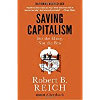 America was once celebrated for and defined by its large and prosperous middle class. Now, this middle class is shrinking, a new oligarchy is rising, and the country faces its greatest wealth disparity in eighty years. Why is the economic system that made America strong suddenly failing us, and how can it be fixed?
America was once celebrated for and defined by its large and prosperous middle class. Now, this middle class is shrinking, a new oligarchy is rising, and the country faces its greatest wealth disparity in eighty years. Why is the economic system that made America strong suddenly failing us, and how can it be fixed?
Click here for more info or to order this book on Amazon.
Beyond Outrage: What has gone wrong with our economy and our democracy, and how to fix it -- by Robert B. Reich
 In this timely book, Robert B. Reich argues that nothing good happens in Washington unless citizens are energized and organized to make sure Washington acts in the public good. The first step is to see the big picture. Beyond Outrage connects the dots, showing why the increasing share of income and wealth going to the top has hobbled jobs and growth for everyone else, undermining our democracy; caused Americans to become increasingly cynical about public life; and turned many Americans against one another. He also explains why the proposals of the “regressive right” are dead wrong and provides a clear roadmap of what must be done instead. Here’s a plan for action for everyone who cares about the future of America.
In this timely book, Robert B. Reich argues that nothing good happens in Washington unless citizens are energized and organized to make sure Washington acts in the public good. The first step is to see the big picture. Beyond Outrage connects the dots, showing why the increasing share of income and wealth going to the top has hobbled jobs and growth for everyone else, undermining our democracy; caused Americans to become increasingly cynical about public life; and turned many Americans against one another. He also explains why the proposals of the “regressive right” are dead wrong and provides a clear roadmap of what must be done instead. Here’s a plan for action for everyone who cares about the future of America.
Click here for more info or to order this book on Amazon.
-
How the Peoples Party Prevailed in 2020
Monday, March 21, 2016Third parties have rarely posed much of a threat to the dominant two parties in America. So how did the People’s Party win the U.S. presidency and a majority of both houses of Congress in 2020?
It started four years before, with the election of 2016.
As you remember, Donald Trump didn’t have enough delegates to become the Republican candidate, so the GOP convention that summer was “brokered” – which meant the Party establishment took control, and nominated the Speaker of the House, Paul Ryan.
Trump tried to incite riots but his “I deserve to be president because I’m the best person in the world!” speech incited universal scorn instead, and he slunk off the national stage (his last words, shouted as he got into his stretch limousine, were “Fu*ck you, America!”)
On the Democratic side, despite a large surge of votes for Bernie Sanders in the final months of the primaries, Hillary Clinton’s stable of wealthy donors and superdelegates put her over the top.
Both Republican and Democratic political establishments breathed palpable sighs of relief, and congratulated themselves on remaining in control of the nation’s politics.
They attributed Trump’s rise to his fanning of bigotry and xenophobia, and Sanders’s popularity to his fueling of left-wing extremism.
They conveniently ignored the deeper anger in both camps about the arbitrariness and unfairness of the economy, and about a political system rigged in favor of the rich and privileged.
And they shut their eyes to the anti-establishment fury that had welled up among independents, young people, poor and middle-class Democrats, and white working-class Republicans.
So they went back to doing what they had been doing before. Establishment Republicans reverted to their old blather about the virtues of the “free market,” and establishment Democrats returned to their perennial call for “incremental reform.”
And Wall Street, big corporations, and a handful of billionaires resumed pulling the strings of both parties to make sure regulatory agencies didn’t have enough staff to enforce rules, and to pass the Trans Pacific Partnership.
Establishment politicians also arranged to reduce taxes on big corporations and simultaneously increase federal subsidies to them, expand tax loopholes for the wealthy, and cut Social Security and Medicare to pay for it all. (“Sadly, we have no choice,” said the new President, who had staffed the White House and Treasury with Wall Streeters and corporate lobbyists, and filled boards and commissions with corporate executives).
Meanwhile, most Americans continued to lose ground.
Even before the recession of 2018, most families were earning less than they’d earned in 2000, adjusted for inflation. Businesses continued to shift most employees off their payrolls and into “on demand” contracts so workers had no idea what they’d be earning from week to week. And the ranks of the working poor continued to swell.
At the same time, CEO pay packages grew even larger, Wall Street bonus pools got fatter, and a record number of billionaires were becoming multi-billionaires.
Then, of course, came the recession, along with bank losses requiring another round of bailouts. The Treasury Secretary, a former managing director of Morgan Stanley, expressed shock and outrage, explaining the nation had no choice and vowing to “get tough” on the banks once the crisis was over.
Politics abhors a vacuum. In 2019, the People’s Party filled it.
Its platform called for getting big money out of politics, ending “crony capitalism,” abolishing corporate welfare, stopping the revolving door between government and the private sector, and busting up the big Wall Street banks and corporate monopolies.
The People’s Party also pledged to revoke the Trans Pacific Partnership, hike taxes on the rich to pay for a wage subsidy (a vastly expanded Earned Income Tax Credit) for everyone earning below the median, and raise taxes on corporations that outsource jobs abroad or pay their executives more than 100 times the pay of typical Americans.
Americans rallied to the cause. Millions who called themselves conservatives and Tea Partiers joined with millions who called themselves liberals and progressives against a political establishment that had shown itself incapable of hearing what they had been demanding for years.
The rest, as they say, is history.

- Wednesday, March 16, 2016
Tell Your Senators to Do Their Job
The Constitution of the United States is clear: Article II Section 2 says the President “shall nominate, and by and with the advice and consent of the Senate, shall appoint … judges to the Supreme Court.”
It doesn’t say the President can’t appoint in the final year of his term of office. In fact, a third of all U.S. presidents have appointed a Supreme Court justice in an election year. Yet many Republicans argue that no appointment can be made in the election year.
And the Constitution doesn’t give the Senate leader the right to delay and obstruct the rest of the Senate fro voting on a President’s nominee. Yet this is what the current Republican leadership argues.
In refusing to vote or even hold a hearing on the President’s nominee to the Supreme Court, the GOP is abdicating its constitutional responsibility. It’s not doing its job.
Senate Republicans are trying to justify their refusal by referring to a comment Joe Biden made when he chaired the Senate Judiciary Committee in 1992, urging then-President Bush to hold off on nominating a Supreme Court justice until after the election. But Biden was speaking hypothetically – there was no nominee before the Senate at that time – and he concluded by saying that if the President were to nominate someone he was sure the Senate and the President could come to an agreement.
This fight has huge implications. A new Supreme Court justice might be able to reverse “Citizens United” and remove the poison of big money from our democracy. It might reverse “Shelby v. Holder,” and resurrect the Voting Rights Act.
And think of the cases coming up – on retaining a woman’s right to choose, on the rights of teachers and other public employees to unionize, on the President’s authority to fight climate change, and the rights of countless Americans with little or no power in a system where more and more power is going to the top. That’s the traditional role of the Supreme Court – to protect the powerless from the powerful.
Which is exactly why the Republicans don’t want to fulfill their constitutional responsibility and allow a vote on the President’s nominee.
So what can you do? There’s only one response – the same response you made when Republicans shut down the government because they didn’t get their way over the debt ceiling: You let them know they’ll be held accountable.
Public pressure is the only way to get GOP senators to release their choke hold on the Supreme Court. Public pressure is up to you. Call your senators now, and tell them you want them to do their job.

-
The New Truth About Free Trade
Monday, March 14, 2016
I used to believe in trade agreements. That was before the wages of most Americans stagnated and a relative few at the top captured just about all the economic gains.
The old-style trade agreements of the 1960s and 1970s increased worldwide demand for products made by American workers, and thereby helped push up American wages.
The new-style agreements increase worldwide demand for products made by American corporations all over the world, enhancing corporate and financial profits but keeping American wages down.
The fact is, recent trade deals are less about trade and more about global investment.
Big American corporations no longer make many products in the United States for export abroad. Most of what they sell abroad they make abroad.
The biggest things they “export” are ideas, designs, franchises, brands, engineering solutions, instructions, and software, coming from a relatively small group of managers, designers, and researchers in the U.S.
The Apple iPhone is assembled in China from components made in Japan, Singapore, and a half-dozen other locales. The only things coming from the U.S. are designs and instructions from a handful of engineers and managers in California.
Apple even stows most of its profits outside the U.S. so it doesn’t have to pay American taxes on them.
Recent “trade” deals have been wins for big corporations and Wall Street, along with their executives and major shareholders, because they get better direct access to foreign markets and billions of consumers.
They also get better protection for their intellectual property – patents, trademarks, and copyrights – and for their overseas factories, equipment, and financial assets.
That’s why big corporations and Wall Street are so enthusiastic about the Trans Pacific Partnership – the giant deal among countries responsible for 40 percent of the global economy.
That deal would give giant corporations even more patent protection overseas. And it would allow them to challenge any nation’s health, safety, and environmental laws that stand in the way of their profits – including our own.
But recent trade deals haven’t been wins for most Americans.
By making it easier for American corporations to make things abroad, the deals have reduced the bargaining power of American workers to get better wages here.
The Trans Pacific Trade Partnership’s investor protections will make it safer for firms to relocate abroad – the Cato Institute describes such protections as “lowering the risk premium” on offshoring – thereby further reducing corporate incentives to make and do things in the United States, using and upgrading the skills of Americans.
Proponents say giant deals like the TPP are good for the growth of the United States economy. But that argument begs the question of whose growth they’re talking about.
Almost all the growth goes to the richest 1 percent. The rest of us can buy some products cheaper than before, but most of those gains would are offset by wage losses.
In theory, the winners could fully compensate the losers and still come out ahead. But the winners don’t compensate the losers.
For example, it’s ironic that the Administration is teaming up with congressional Republicans to enact the TPP, when congressional Republicans have done just about everything they can to keep down the wages of most Americans.
They’ve refused to raise the minimum wage (whose inflation-adjusted value is now almost 25 percent lower than it was in 1968), expand unemployment benefits, invest in job training, enlarge the Earned Income Tax Credit, improve the nation’s infrastructure, or expand access to public higher education.
They’ve embraced budget austerity that has slowed job and wage growth. And they’ve continued to push “trickle-down” economics – keeping tax rates low for America’s richest, protecting their tax loopholes, and fighting off any attempt to raise taxes on wealthy inheritances to their level before 2000.
I’ve seen first-hand how effective Wall Street and big corporations are at wielding influence – using lobbyists, campaign donations, and subtle promises of future jobs to get the global deals they want.
Global deals like the Trans Pacific Partnership will boost the profits of Wall Street and big corporations, and make the richest 1 percent even richer. But they’ll contribute the to steady shrinkage of the American middle class.
-
Are Trade Deals Good for America?
Monday, March 14, 2016Both Bernie Sanders and Donald Trump are blaming free-trade deals for the decline of working-class jobs and incomes. Are they right?
Clearly, America has lost a significant number of factory jobs over the last three decades. In 1980, 1 in 5 Americans worked in manufacturing. Now it’s 1 in 12.
Today Ohio has a third fewer manufacturing jobs than it had in 2000. Michigan is down 32 percent.
Trade isn’t the only culprit. Technological change has also played a part.
When I visit one of America’s remaining factories, I rarely see assembly-line workers. I don’t see many workers at all. Instead, I find a handful of technicians sitting behind computer screens. They’re linked to fleets of robots and computerized machine tools who do the physical work.
There’s a lively debate among researchers as to whether trade or technology is more responsible for the decline in factory jobs. In reality the two can’t be separated.
Were it not for technological breakthroughs we wouldn’t have the huge cargo containers, massive container ports and cranes, and satellite and Internet communications systems that have created highly-efficiently worldwide manufacturing systems.
These systems have relocated factory jobs from the United States to Asia, especially to China. Researchers find the biggest losses in American manufacturing started in 2001 when China joined the World Trade Organization, requiring the U.S. to lower tariffs on Chinese goods.
MIT economist David Autor and two co-authors estimate that between 2000 and 2007 the United States lost close to a million manufacturing jobs to China – about a quarter of the total decline in those years. Robert Scott of the Economic Policy Institute puts the loss since then at about 3 million.
This doesn’t mean free trade has been entirely bad for Americans. It’s given us access to cheaper goods, saving the typical American thousands of dollars a year.
A recent study by economists at UCLA and Columbia University found that trade has increased the real incomes of the U.S. middle class by 29 percent, and even more for those with lower incomes.
But trade has widened inequality and imposed a particular burden on America’s blue-collar workers.
If you’re well educated, free trade has given you better access worldwide markets for your skills and insights – resulting directly or indirectly in higher pay.
On the other hand, if you’re not well educated, the trade deals of the last quarter century have very likely taken away the factory job you (or your parents or grandparents) once relied on for steady work with good pay and generous benefits.
These jobs were the backbone of the old American middle class. Now they’re almost all gone, replaced by lower-paying service jobs in places like retail stores, restaurants, hotels, and hospitals.
The change has been a dramatic. A half century ago America’s largest private-sector employer was General Motors, whose full-time workers earned an average hourly income (including health and pension benefits) of around $50, in today’s dollars.
Today America’s largest employer is Walmart, whose typical employee earns just over $9 an hour. A third of Walmart’s employees work less than 28 hours per week and don’t even qualify for benefits.
The core problem isn’t really free trade, or even the loss of factory jobs per se. It’s the demise of an entire economic system in which people with only high-school degrees, or less, could count on good and secure jobs.
That old system included strong unions, CEOs with responsibilities to their employees and communities and not just to shareholders, and a financial sector that didn’t demand the highest possible returns every quarter.
Trade has contributed to the loss of this old system, but that doesn’t necessarily mean we should give up on free trade. We should create a new system, in which a greater share of Americans can be winners.
But will we? The underlying political question is whether the winners from America’s current economic system – people with college degrees, the right connections, and good jobs that put them on the winning side of the divide – will support new rules that widen the circle of prosperity to include those who have been on the losing side.
Those new rules might include, for example, a much larger Earned Income Tax Credit (effectively, a wage subsidy for lower-income workers), stronger unions in the service sector, world-class education for all (including free public higher education), a single-payer healthcare plan, more generous Social Security, and higher taxes on the wealthy to pay for all this.
If the winners refuse to budge, America could turn its back on free trade – and much else. Indeed, there’s no telling where the anger we’ve seen this primary might lead.

-
The American Fascist
Tuesday, March 8, 2016I’ve been reluctant to use the “f” word to describe Donald Trump because it’s especially harsh, and it’s too often used carelessly.
But Trump has finally reached a point where parallels between his presidential campaign and the fascists of the first half of the 20th century – lurid figures such as Benito Mussolini, Joseph Stalin, Adolf Hitler, Oswald Mosley, and Francisco Franco – are too evident to overlook.
It’s not just that Trump recently quoted Mussolini (he now calls that tweet inadvertent) or that he’s begun inviting followers at his rallies to raise their right hands in a manner chillingly similar to the Nazi “Heil” solute (he dismisses such comparison as “ridiculous.”)
The parallels go deeper.
As did the early twentieth-century fascists, Trump is focusing his campaign on the angers of white working people who have been losing economic ground for years, and who are easy prey for demagogues seeking to build their own power by scapegoating others.
Trump’s electoral gains have been largest in counties with lower than average incomes, and among those who report their personal finances have worsened. As the Washington Post’s Jeff Guo has pointed out, Trump performs best in places where middle-aged whites are dying the fastest.
The economic stresses almost a century ago that culminated in the Great Depression were far worse than most of Trump’s followers have experienced, but they’ve suffered something that in some respects is more painful – failed expectations.
Many grew up during the 1950s and 1960s, during a postwar prosperity that lifted all boats. That prosperity gave their parents a better life. Trump’s followers naturally expected that they and their children would also experience economic gains. They have not.
Add fears and uncertainties about terrorists who may be living among us, or may want to sneak through our borders, and this vulnerability and powerlessness is magnified.
Trump’s incendiary verbal attacks on Mexican immigrants and Muslims – even his reluctance to distance himself from David Duke and the Ku Klux Klan – follow the older fascist script.
That older generation of fascists didn’t bother with policy prescriptions or logical argument, either. They presented themselves as strongmen whose personal power would remedy all ills.
They created around themselves cults of personality in which they took on the trappings of strength, confidence, and invulnerability – all of which served as substitutes for rational argument or thought.
Trump’s entire campaign similarly revolves around his assumed strength and confidence. He tells his followers not to worry; he’ll take care of them. “If you get laid off …, I still want your vote,” he told workers in Michigan last week. “I’ll get you a new job; don’t worry about it.”
The old fascists intimidated and threatened opponents. Trump is not above a similar strategy. To take one example, he recently tweeted that Chicago’s Ricketts family, now spending money to defeat him, “better be careful, they have a lot to hide.”
The old fascists incited violence. Trump has not done so explicitly but Trump supporters have attacked Muslims, the homeless, and African-Americans – and Trump has all but excused their behavior.
Weeks after Trump began his campaign by falsely alleging that Mexican immigrants are “bringing crime. They’re rapists,” two brothers in Boston beat with a metal pole and urinated on a 58-year-old homeless Mexican national. They subsequently told the police “Donald Trump was right, all these illegals need to be deported.”
Instead of condemning that brutality, Trump excused it by saying “people who are following me are very passionate. They love this country and they want this country to be great again.”
After a handful of white supporters punched and attempted to choke a Black Lives Matter protester at one of his campaign rallies, Trump said “maybe he should have been roughed up.”
There are further parallels. Fascists glorified national power and greatness, fanning xenophobia and war. Trump’s entire foreign policy consists of asserting American power against other nations. Mexico “will” finance a wall. China “will” stop manipulating its currency.
In pursuit of their nationalistic aims, the fascists disregarded international law. Trump is the same. He recently proposed using torture against terrorists, and punishing their families, both in clear violation of international law.
Finally, the fascists created their mass followings directly, without political parties or other intermediaries standing between them and their legions of supporters.
Trump’s tweets and rallies similarly circumvent all filters. The Republican Party is irrelevant to his campaign, and he considers the media an enemy. (Reporters covering his rallies are kept behind a steel barrier.)
Viewing Donald Trump in light of the fascists of the first half of the twentieth century – who used economic stresses to scapegoat others, created cults of personality, intimidated opponents, incited violence, glorified their nations and disregarded international law, and connected directly with the masses – helps explain what Trump is doing and how he is succeeding.
It also suggests why Donald Trump presents such a profound danger to the future of America and the world.

-
Why the Critics of Bernienomics Are Wrong
Wednesday, March 2, 2016Not day goes by, it seems, without the mainstream media bashing Berney Sanders’s economic plan – quoting certain economists as saying his numbers don’t add up. (The New York Times did it again just yesterday.) They’re wrong. You need to know the truth, and spread it.
1. “Well, do the numbers add up?”
Yes, if you assume a 3.8 percent rate of unemployment and a 5.3 percent rate of growth.
2. “But aren’t these assumptions unrealistic?”
They’re not out of the range of what’s possible. After all, we achieved close to 3.8 percent unemployment in the late 1990s, and we had a rate of 5.3 percent growth in the early 1980s.
3. “What is it about Bernie’s economic plan that will generate this kind of economic performance?”
His proposal for a single-payer healthcare system.
4. “But yesterday’s New York Times reported that two of your colleagues at Berkeley found an error in the calculations underlying these estimates. They claim Professor Gerald Friedman mistakenly assumes that a one-time boost in growth will continue onward. They say he confuses levels of output with rates of change.”
My esteemed colleagues see only a temporary effect from moving to a single-payer plan. But that view isn’t shared by economists who find that a major policy change like this can permanently improve economic performance. After all, World War II got America out of the Great Depression – permanently.
5. “So you think Bernie’s plan will generate a permanent improvement in the nation’s economic performance?”
Yes. Given that healthcare expenditures constitute almost 18 percent of the U.S. economy – and that ours is the most expensive healthcare system in the world, based on private for-profit insurance companies and pharmaceutical companies that spend fortunes on advertising, marketing, administrative costs, high executive salaries, and payouts to shareholders – it’s not far-fetched to assume that adoption of a single-payer plan will permanently improve U.S. economic performance.

-
An Open Letter to the Republican Establishment
Sunday, February 28, 2016You are the captains of American industry, the titans of Wall Street, and the billionaires who for decades have been the backbone of the Republican Party.
You’ve invested your millions in the GOP in order to get lower taxes, wider tax loopholes, bigger subsidies, more generous bailouts, less regulation, lengthier patents and copyrights and stronger market power allowing you to raise prices, weaker unions and bigger trade deals allowing you outsource abroad to reduce wages, easier bankruptcy for you but harder bankruptcy for homeowners and student debtors, and judges who will let you to engage in insider trading and who won’t prosecute you for white-collar crimes.
All of which have made you enormously wealthy. Congratulations.
But I have some disturbing news for you. You’re paying a big price – and about to pay far more.
First, as you may have noticed, most of your companies aren’t growing nearly as fast as they did before the Great Recession. Your sales are sputtering, and your stock prices are fragile.
That’s because you forgot that your workers are also consumers. As you’ve pushed wages downward, you’ve also squeezed your customers so tight they can hardly afford to buy what you have to sell.
Consumer spending comprises 70 percent of the American economy. But the typical family is earning less today than it did in 2000, in terms of real purchasing power.
Most of the economic gains have gone to you and others like you who spend only a small fraction of what they rake in. That spells trouble for the economy – and for you.
You’ve tried to lift your share prices artificially by borrowing money at low interest rates and using it to buy back your shares of stock. But this party trick works only so long. Besides, interest rates are starting to rise.
Second, you’ve instructed your Republican lackeys to reduce your and your corporation’s taxes so much over the last three decades – while expanding subsidies and bailouts going your way – that the government is running out of money.
That means many of the things you and your businesses rely on government to do – build and maintain highways, bridges, tunnels, and other physical infrastructure; produce high-quality basic research; and provide a continuous supply of well-educated young people – are no longer being done as well as they should. If present trends continue, all will worsen in years to come.
Finally, by squeezing wages and rigging the economic game in your favor, you have invited an unprecedented political backlash – against trade, immigration, globalization, and even against the establishment itself.
The pent-up angers and frustrations of millions of Americans who are working harder than ever yet getting nowhere, and who feel more economically insecure than ever, have finally erupted. American politics has become a cesspool of vitriol.
Republican politicians in particular have descended into the muck of bigotry, hatefulness, and lies. They’re splitting America by race, ethnicity, and religion. The moral authority America once had in the world as a beacon of democracy and common sense is in jeopardy. And that’s not good for you, or your businesses.
Nor is the uncertainty all this is generating. A politics based on resentment can lurch in any direction at almost any time. Yet you and your companies rely on political stability and predictability.
You follow me? You’ve hoisted yourself on your own petard. All that money you invested in Republican Party in order to reap short-term gains is now reaping a whirlwind.
You would have done far better with a smaller share of an economy growing more rapidly because it possessed a strong and growing middle class.
You’d have done far better with a political system less poisoned by your money – and therefore less volatile and polarized, more capable of responding to the needs of average people, less palpably rigged in your favor.
But you were selfish and greedy, and you thought only about your short-term gains.
You forgot the values of a former generation of Republican establishment that witnessed the devastations of the Great Depression and World War II, and who helped build the great post-war American middle class.
That generation did not act mainly out of generosity or social responsibility. They understood, correctly, that broad-based prosperity would be good for them and their businesses over the long term.
So what are you going to do now? Will you help clean up this mess – by taking your money out of politics, restoring our democracy, de-rigging the system, and helping overcome widening inequality of income, wealth, and political power?
Or are you still not convinced?

- Friday, February 26, 2016
10 Reasons Marco Rubio is no Moderate
Marco Rubio is being positioned as a moderate alternative to Ted Cruz or Donald Trump. Baloney. His positions are extreme right. Consider these 10 facts about Rubio:
1. Rubio wants to repeal Obama’s executive order to expand background checks and close gun sale loopholes.
2. When asked about closing down mosques, Rubio said he wants to shutdown “any place radicals are inspired.”
3. He denies humans are responsible for climate change.
4. His tax plan gives the top 1 percent over $200,000 in tax cuts every year. That’s as bad as Donald Trump’s tax plan.
5. He wants to cut $4.3 trillion in spending, including funds from Medicare and other programs, essentially freeze federal spending at 2008 levels for everything except the Pentagon.
6. He wants a permanent U.S. presence in Iraq, and would end the nuclear deal with Iran, putting us on a path to war.
7. We have no way to know where he is on immigration because he’s flip-flopped — first working on legislation to regularize citizenship for undocumented immigrants, and now firmly anti-legalization.
8. He wants to repeal Obamacare.
9. He’s against a woman’s right to choose, even in cases of rape and incest.
10. Although elected to the Senate as a Tea Party favorite, he’s now the establishment’s favorite Republican. Among his donors are hedge-fund billionaire Paul Singer and the executives and PACs of Goldman Sachs, Wells Fargo, and Koch Industries.

-
The End of the Establishment?
Monday, February 22, 2016Step back from the campaign fray for just a moment and consider the enormity of what’s already occurred.
A 74-year-old Jew from Vermont who describes himself as a democratic socialist, who wasn’t even a Democrat until recently, has come within a whisker of beating Hillary Clinton in the Iowa caucus, routed her in the New Hampshire primary, and garnered over 47 percent of the caucus-goers in Nevada, of all places.
And a 69-year-old billionaire who has never held elective office or had anything to do with the Republican Party has taken a commanding lead in the Republican primaries.
Something very big has happened, and it’s not due to Bernie Sanders’ magnetism or Donald Trump’s likeability.
It’s a rebellion against the establishment.
The question is why the establishment has been so slow to see this. A year ago – which now seems like an eternity – it proclaimed Hillary Clinton and Jeb Bush shoo-ins.
Both had all the advantages – deep bases of funders, well-established networks of political insiders, experienced political advisors, all the name recognition you could want.
But even now that Bush is out and Hillary is still leading but vulnerable, the establishment still doesn’t see what’s occurred. They explain everything by pointing to weaknesses: Bush, they now say, “never connected” and Hillary “has a trust problem.”
A respected political insider recently told me most Americans are largely content. “The economy is in good shape,” he said. “Most Americans are better off than they’ve been in years. The problem has been the major candidates themselves.”
I beg to differ.
Economic indicators may be up but they don’t reflect the economic insecurity most Americans still feel, nor the seeming arbitrariness and unfairness they experience.
Nor do the major indicators show the linkages Americans see between wealth and power, crony capitalism, declining real wages, soaring CEO pay, and a billionaire class that’s turning our democracy into an oligarchy.
Median family income is lower now than it was sixteen years ago, adjusted for inflation.
Most economic gains, meanwhile, have gone to top.
These gains have translated into political power to rig the system with bank bailouts, corporate subsidies, special tax loopholes, trade deals, and increasing market power – all of which have further pushed down wages and pulled up profits.
Those at the very top of the top have rigged the system even more thoroughly. Since 1995, the average income tax rate for the 400 top-earning Americans has plummeted from 30 percent to 18 percent.
Wealth, power, and crony capitalism fit together. So far in the 2016 election, the richest 400 Americans have accounted for over a third of all campaign contributions.
Americans know a takeover has occurred and they blame the establishment for it.
There’s no official definition of the “establishment” but it presumably includes all of the people and institutions that have wielded significant power over the American political economy, and are therefore deemed complicit.
At its core are the major corporations, their top executives, and Washington lobbyists and trade associations; the biggest Wall Street banks, their top officers, traders, hedge-fund and private-equity managers, and their lackeys in Washington; the billionaires who invest directly in politics; and the political leaders of both parties, their political operatives, and fundraisers.
Arrayed around this core are the deniers and apologists – those who attribute what’s happened to “neutral market forces,” or say the system can’t be changed, or who urge that any reform be small and incremental.
Some Americans are rebelling against all this by supporting an authoritarian demagogue who wants to fortify America against foreigners as well as foreign-made goods. Others are rebelling by joining a so-called “political revolution.”
The establishment is having conniptions. They call Trump whacky and Sanders irresponsible. They charge that Trump’s isolationism and Bernie’s ambitious government programs will stymie economic growth.
The establishment doesn’t get that most Americans couldn’t care less about economic growth because for years they’ve got few of its benefits, while suffering most of its burdens in the forms of lost jobs and lower wages.
Most people are more concerned about economic security and a fair chance to make it.
The establishment doesn’t see what’s happening because it has cut itself off from the lives of most Americans. It also doesn’t wish to understand, because that would mean acknowledging its role in bringing all this on.
Yet regardless of the political fates of Donald Trump and Bernie Sanders, the rebellion against the establishment will continue.
Eventually, those with significant economic and political power in America will have to either commit to fundamental reform, or relinquish their power.





